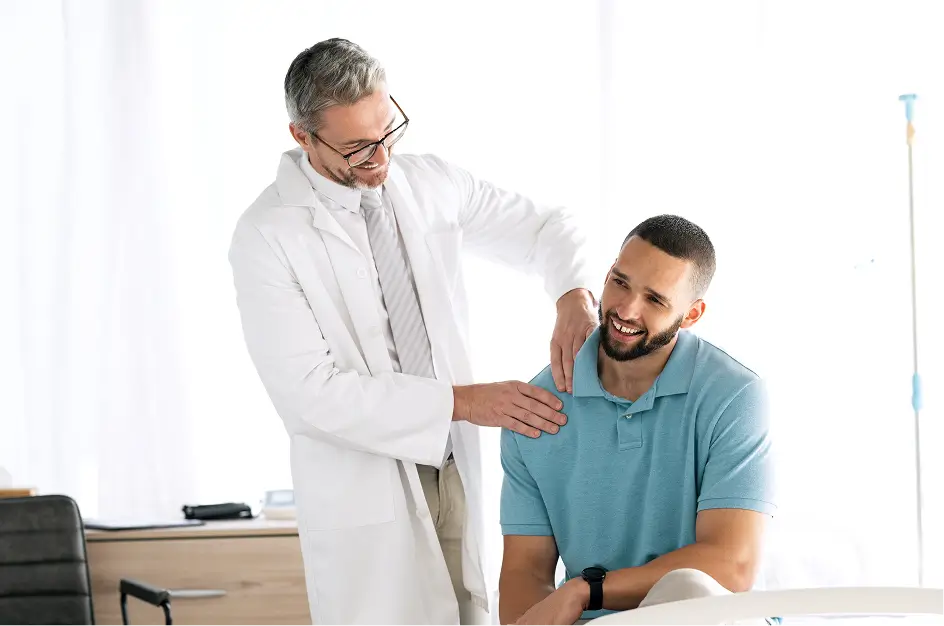Shoulder Stem-Cell Therapy in Dallas–
Fort Worth
Non-Surgical Relief for Rotator-Cuff Tears, Labrum Lesions & Frozen Shoulder
Why Choose NTX Regen Center?
Three-Specialty Team
One visit = three expert opinions & a unified plan
Live Ultrasound or X-ray guidance
Precise needle placement into the tiny cuff & labrum zones
On-site MRI, cell lab & rehab
Diagnose, treat & strengthen without extra trips
5 DFW Locations
+ Saturdays
Get treated when pain flares, not weeks later
Rated 4.8 Stars
by Patients
Real results for your North-Texas neighbors
Shoulder Conditions We Treat
- Partial-thickness rotator-cuff tears
- Post-surgical pain when anchors remain intact
- Mild-to-moderate shoulder osteoarthritis
- Persistent bursitis unresponsive to steroid shots
- SLAP lesions & labrum fraying
Two-Month Shoulder Regeneration Plan
Day 0
Comprehensive Consult
(clinical exam + dynamic ultrasound)
MRI (if needed) & Stem-Cell Collection
from hip marrow or blood
Rapid Cell Concentration (~45 min)
in ISO-Class 5 lab
Image-Guided Injection
to cuff, labrum & joint capsule
Week 1-5
Six Class IV Laser + Shoulder-Stability PT Visits
Week 6
Optional PRP “Booster” Injection
for high-demand shoulders
Week 8
Mobility & Strength Re-Check
with return-to-sport plan
Why Patients Pick Stem-Cells Over Surgery
- Repairs—not just numbs—micro-tears
- Walk-out procedure (≈2 hrs; sling optional)
- 100 % autologous—nothing foreign added
- Rehab built in, so gains last
Stem Cells vs Steroid Shots vs Fusion
Replacement
Evidence Snapshot
- 78 % of partial-tear patients avoided surgery 18 months after a single stem-cell injection
- Mean pain scores dropped 63 % at one year in mild shoulder arthritis across three U.S. centers
Recovery Timeline – What You’ll Feel
Day 0
Mild ache; ice eases soreness
Weeks 1
Sling optional; desk work OK
Week 6
Lifting 5–10 lb; ROM improving
Week 8
Strength test & green light for sports drills

Meet Our Care Team
Board-Certified Orthopedic Spine Surgeon
- Specializes in cervical, thoracic, and lumbar spine surgery
- Fellowship-trained in spinal reconstruction surgery
- Board Certified by the American Osteopathic Board of Orthopedic Surgeons
- Published researcher in Spine and national conference presenter (NASS, SRS)
Board-Certified Pain Management & Rehabilitation Specialist
- Fellowship-trained in interventional spine & pain management
- Board Certified in Physical Medicine and Rehabilitation
- Expertise in musculoskeletal pain, neuromuscular disorders, and electrodiagnostics
- Member of AAPMR, AAP, and American Osteopathic Association
Board-Certified Radiologist & Neuroradiologist
- Board Certified in Radiology with CAQs in Interventional Radiology and Neuroradiology
- Fellowship-trained in both interventional radiology and neuroradiology
- Former Chief Resident at University of Nebraska Medical Center
- Member of ACR, RSNA, SIR, and International Spine Intervention Society
Now Offering Shoulder Stem Cell Across DFW
What Our Patients Are Saying
Sandra
“Quick, Polite and professional staff. The Dr was very informative and thorough in discussing.my injuries and options available to me.”
Kathleen
“Very professional , never have wait , all staff have excellent bedside manner..friendly considerate of medical situation recommend to anyone”
Leonor Luna
“I would recomend this clinic because they have the patience i like this clinic”
Frequently Asked Questions
Which shoulder injuries respond to stem-cell therapy?
Partial rotator-cuff tears, chronic tendonitis, SLAP or labral frays, early arthritis and bursitis are common targets for image-guided shoulder stem-cell treatment.
How does regenerative stem-cell therapy help shoulder healing?
Mesenchymal cells from your marrow or fat release growth factors that may calm inflammation, remodel collagen and support long-term tendon and cartilage repair.
Can stem-cell injections replace arthroscopic shoulder surgery?
For many active adults with partial tears or degenerative changes, non-surgical shoulder stem-cell therapy can postpone—or sometimes avoid—arthroscopic repair.
What imaging guides the shoulder stem-cell injection?
High-resolution ultrasound, and fluoroscopy when needed, place the cell concentrate precisely into the rotator-cuff tendon, labrum or glenohumeral joint.
How soon can I resume overhead activities?
After 48 hours of rest, gentle range-of-motion work begins; resistance training and sports like tennis or pitching typically return in six–eight weeks.
How long do results from shoulder stem-cell therapy last?
Many patients enjoy pain relief and improved motion for 9–18 months or longer, especially when combined with targeted physiotherapy at NTX Regen Center in Dallas-Fort Worth.